Composite Oxide Fibres Grown by Internal Crystallisation Method
Abstract
:1. Introduction
2. Fabrication of Composite Fibres
3. Microstructure of the Fibres
- (1)
- The “black” phase corresponds to alumina; “grey” phases of various degrees of darkness correspond to various calcium aluminates (CAs).
- (2)
- The sizes of the CAs inclusions are too small to measure Al:Ca atomic rations given precisely. Still, it is clear that all the CAs including CA6 are present in the fibres.
- (3)
- The configuration of the inclusion systems in the fibre seen in a longitudinal section of a composite (Figure 3a) is determined, perhaps, by special conditions of fibre crystallisation in the molybdenum carcass determined by the high thermal conductivity of molybdenum, which determines the radial temperature gradients.
- (4)
- A difference in the appearance of the fibre microstructures in Figure 3a, Figure 1b is mainly determined by the difference in the crystallisation rate being ~250 and <1 mm/min, respectively. Increasing the crystallisation rate yields a decrease in the characteristic size of the fibre microstructure. Obviously, the temperature gradient in the crystallisation zone affects the fibre microstructure as well. In all the present experiments, the gradient was ~1.5 °C/mm.
4. Mechanical Properties of Oxide/Molybdenum Composites
5. Conclusions
- A possibility of obtaining oxide fibres composed of sapphire and calcium aluminate inclusions by using the internal crystallisation method is shown.
- Measurements of fracture toughness and observation of the microstructure of the fracture zone in front of the notch tip of the model composites with brittle molybdenum matrices and the oxide fibres containing CA6-inclusions show that such inclusions can arrest crack propagation.
- At present, the crystallisation mechanisms of oxide fibres with CA6-inclusions is not completely clear. Optimisation of the microstructures and the crystallisation process is necessary to make oxide composite fibres for important reinforcements for brittle matrices to launch a new type of brittle-fibre/brittle-matrix composite with a quasi-plastic behaviour.
Acknowledgments
Author Contributions
Conflicts of Interest
References
- Aveston, J.; Cooper, G.A.; Kelly, A. Single and multiply fracture, the properties of fibre composites. In Proceedings of the Conference the Properties of Fibre Composites, National Physical Laboratory, Teddington, UK, 4 November 1971; IPC Science and Technology Press Ltd.: Teddington, UK, 1971; pp. 15–26. [Google Scholar]
- Naslain, R.; Dugne, O.; Guette, A.; Sevely, J.; Robin-Brosse, C.; Rocher, J.P.; Cotteret, J. Boron nitride interphase in ceramic matrix composites. J. Am. Ceram. Soc. 1991, 74, 2482–2488. [Google Scholar] [CrossRef]
- Cinibulk, M.K. Hexaluminates as a cleavable fiber–matrix interphase: Synthesis, texture development, and phase compatibility. J. Eur. Ceram. Soc. 2000, 20, 569–582. [Google Scholar] [CrossRef]
- Institute of Experimental Mineralogy, Chernogolovka, Russia. Available online: http://database.iem.ac.ru/mincryst/s_carta.php?HIBONITE (accessed on 9 January 2016).
- Kuo, D.H.; Kriven, W.M.; Mackin, T.J. Control of interfacial properties through fiber coatings: Monazite coatings in oxide-oxide composites. J. Am. Ceram. Soc. 1997, 80, 2987–2995. [Google Scholar] [CrossRef]
- Mileiko, S.T. Single crystalline oxide fibres for heat-resistant composites. Compos. Sci. Technol. 2005, 65, 2500–2513. [Google Scholar] [CrossRef]
- Wilson, D.M.; Visser, L.R. High performance oxide fibers for metal and ceramic composites. Compos. Part A 2001, 32, 1143–1153. [Google Scholar] [CrossRef]
- Keller, K.A.; Jefferson, G.; Kerans, R.J. Oxide–oxide composites. In Ceramic Matrix Composites: Materials, Modeling and Technology; Bansal, N.P., Lamon, J., Eds.; Wiley: Hoboken, NJ, USA, 2014. [Google Scholar]
- LaBelle, H.E., Jr.; Mlavsky, A.I. Growth of sapphire filaments from the melt. Nature 1967, 216, 574–575. [Google Scholar] [CrossRef]
- Burrus, C.A.; Coldren, L.A. Growth of single-crystal sapphire-clad ruby fibers. Appl. Phys. Lett. 1977, 31, 383–384. [Google Scholar] [CrossRef]
- Yoon, D.H.; Fukuda, T. Characterization of LiNbO3 micro single crystals grown by the micro-pulling-down method. J. Cryst. Growth 1994, 144, 201–206. [Google Scholar] [CrossRef]
- Mileiko, S.T. Internal crystallisation method to produce oxide fibres and heat resistant composites. In Recrystallization in Materials Processing; Glebovsky, V., Ed.; InTech: Rijeka, Croatia, 2015; pp. 125–168. Available online: http://www.intechopen.com/books/recrystallization-in-materials-processing/internal-crystallisation-method-to-produce-oxide-fibres-and-heat-resistant-composites (accessed on 15 August 2017).
- Popova, N.A.; Tolstun, A.N. A monazite imterphase in oxide/oxide composites with ICM-fibrers. Sci. Ind. 2007, 2, 58–61. (In Russian) [Google Scholar]
- Phase Equilibria Diagrams, ACerS–NIST. 2003. Version 3. CD-ROM Database. Available online: http://ceramics.org/publications-and-resources/phase-equilibria-diagrams (accessed on 20 August 2017).
- Mileiko, S.T. Fracture-toughness/notch-sensitivity correlation for metal- and ceramic-based fibrous composites. Compos. Part B 2017, 116, 1–6. [Google Scholar] [CrossRef]
- Mileiko, S.T.; Kazmin, V.I. Structure and mechanical properties of oxide fibre reinforced metal matrix composites produced by the internal crystallisation method. Compos. Sci. Technol. 1992, 45, 209–220. [Google Scholar] [CrossRef]

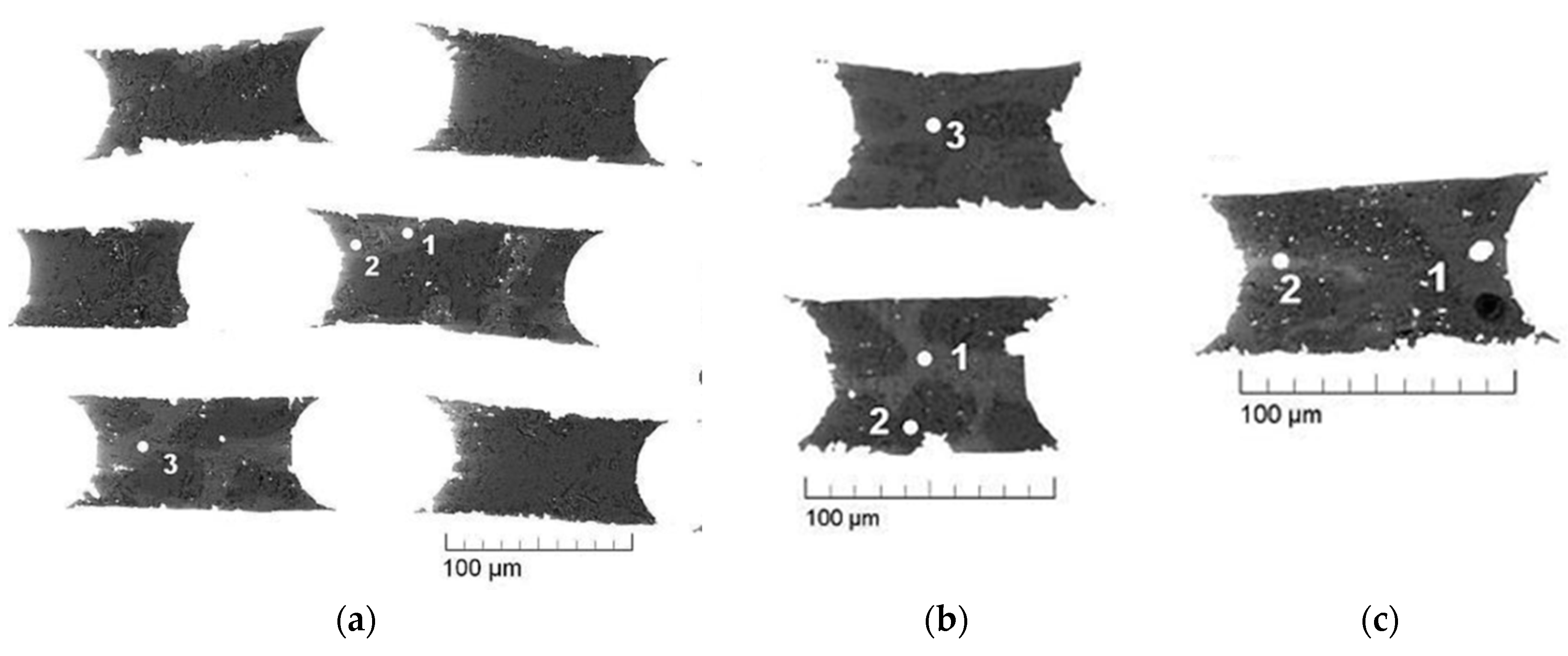
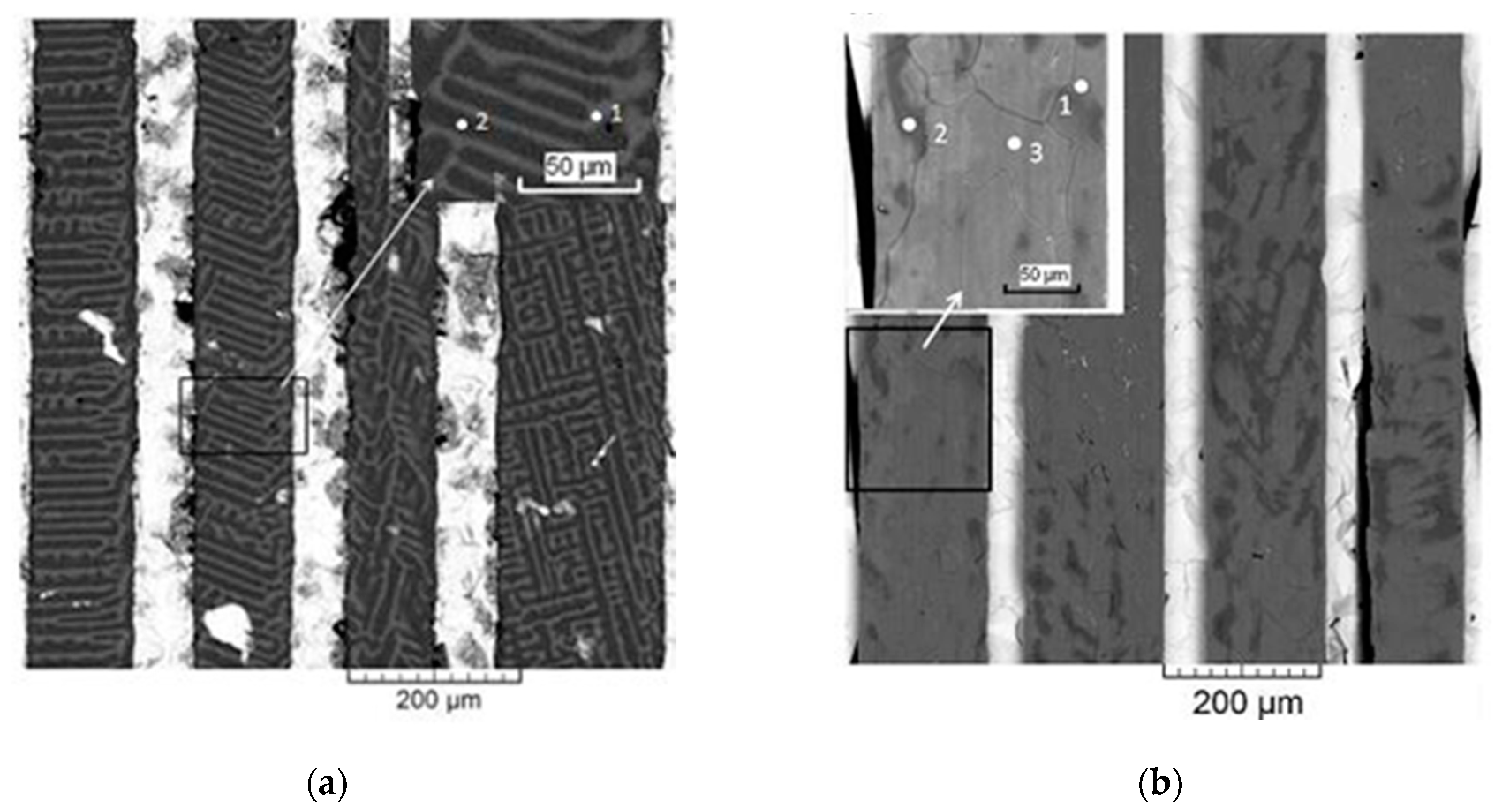
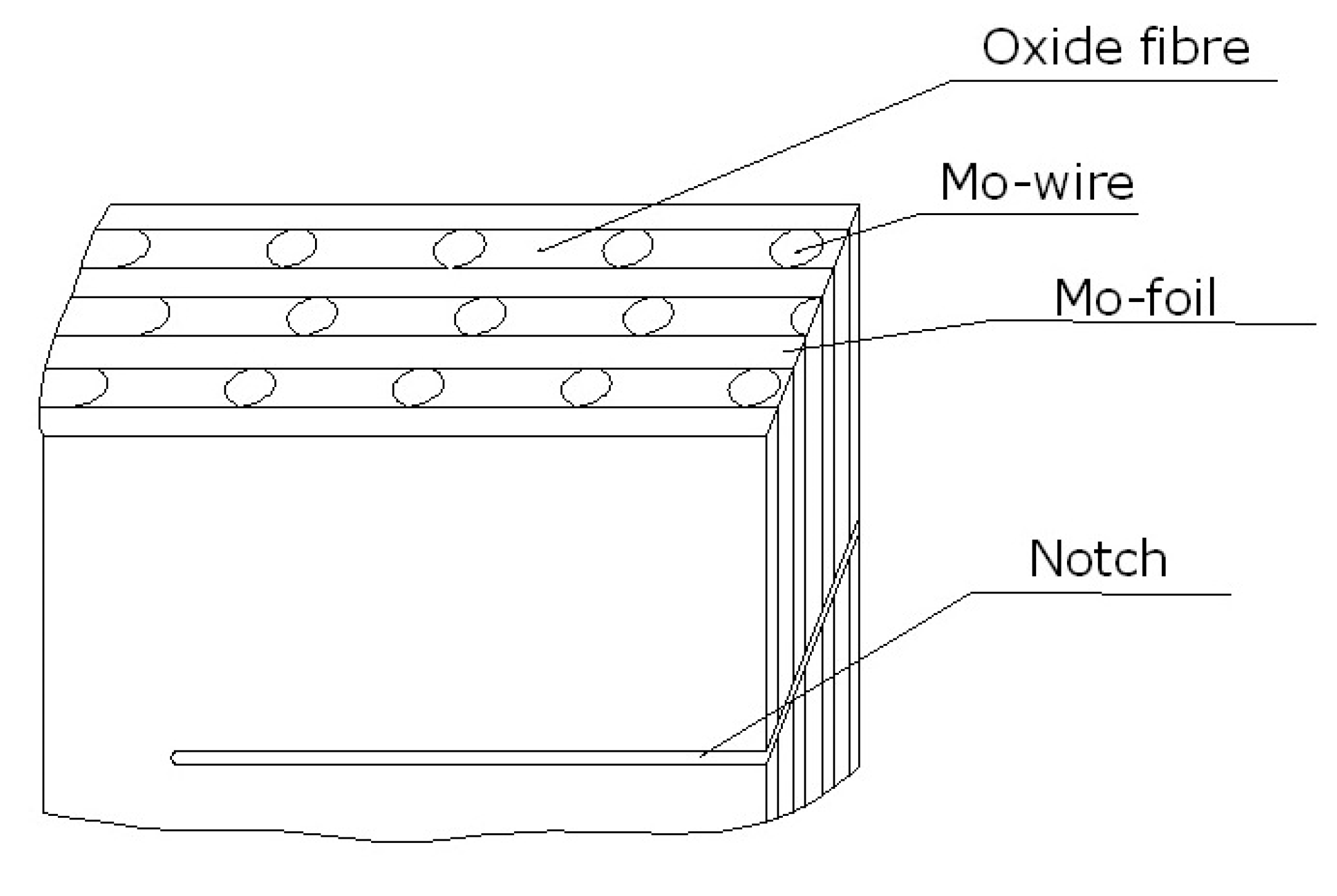
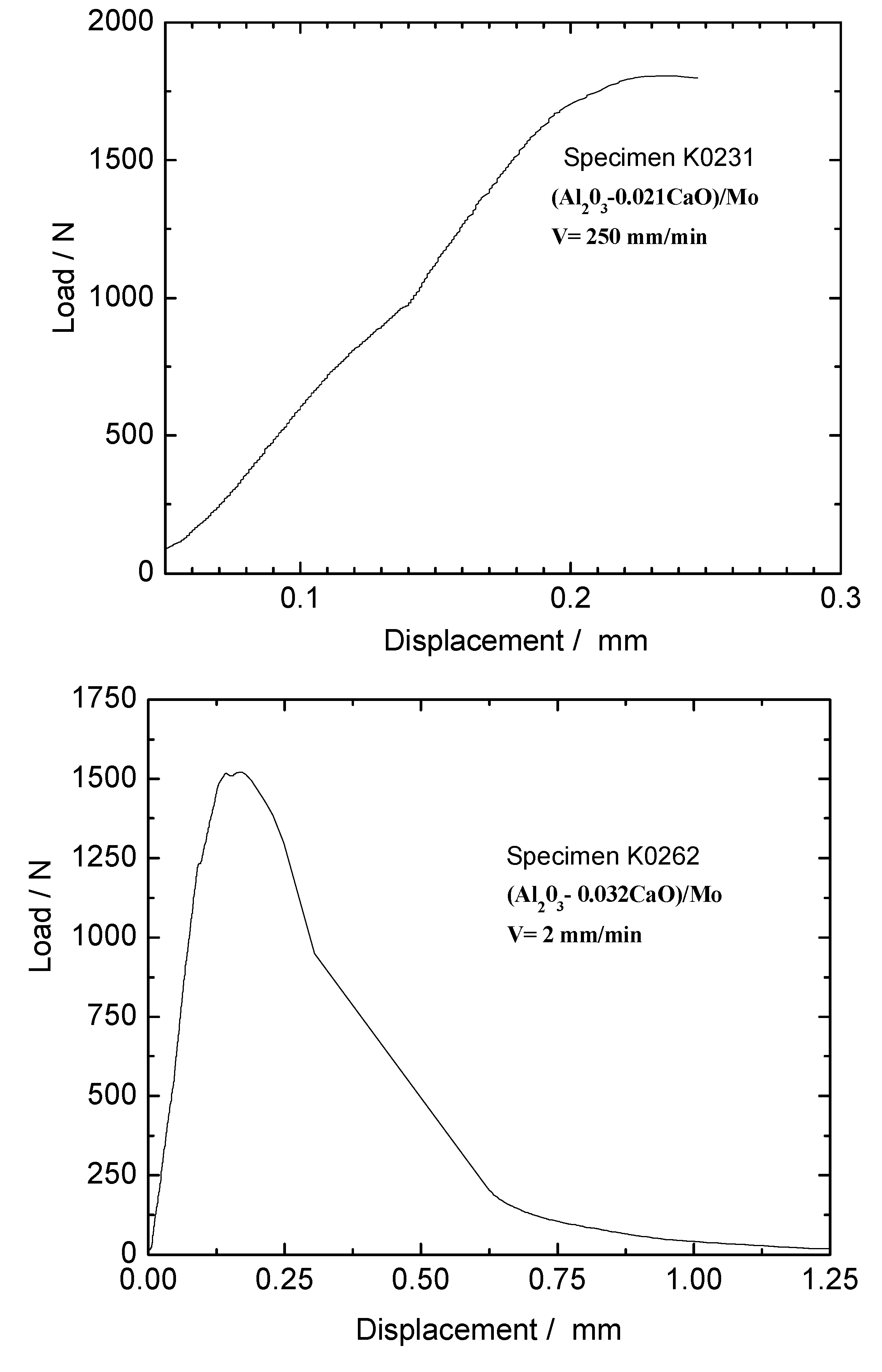
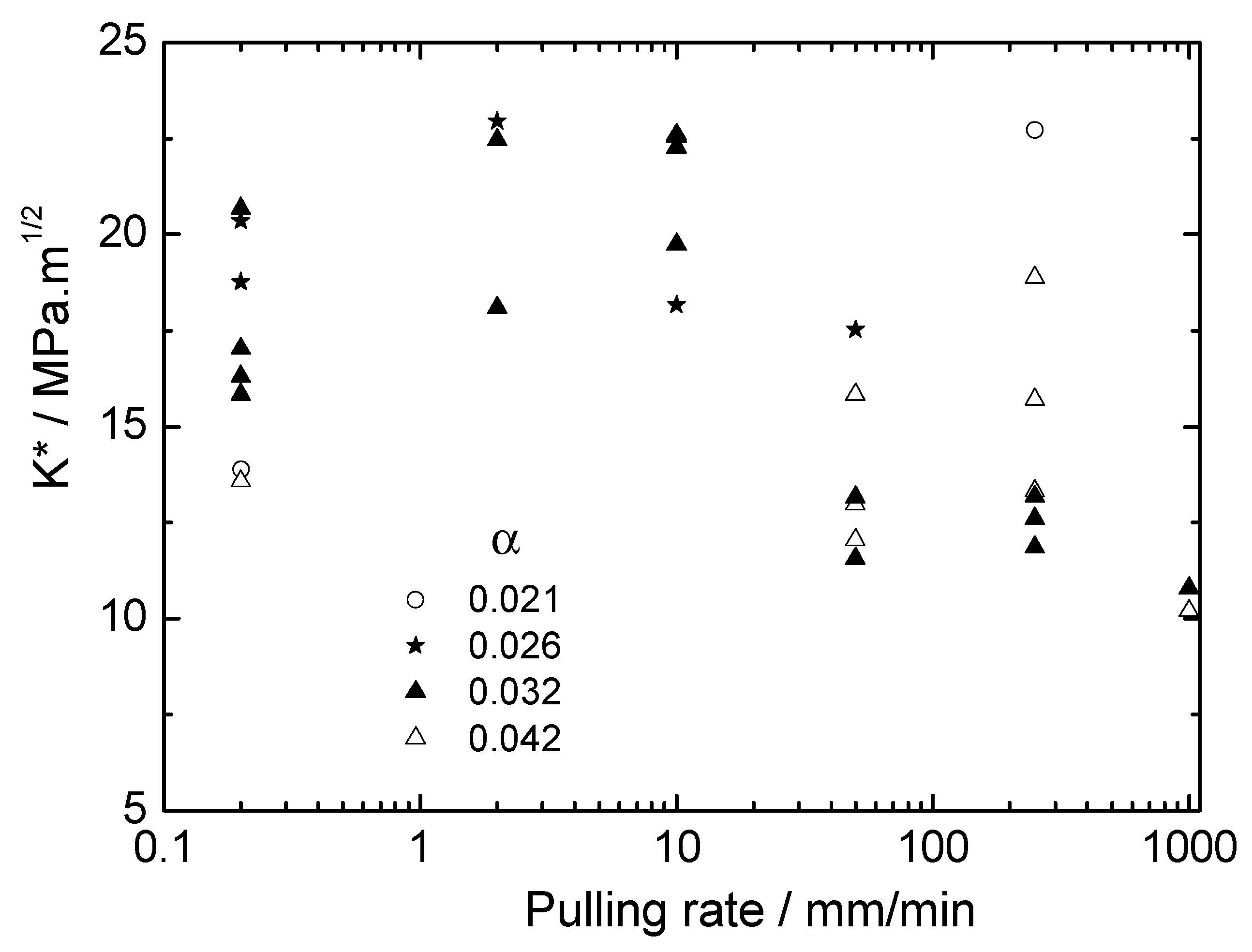
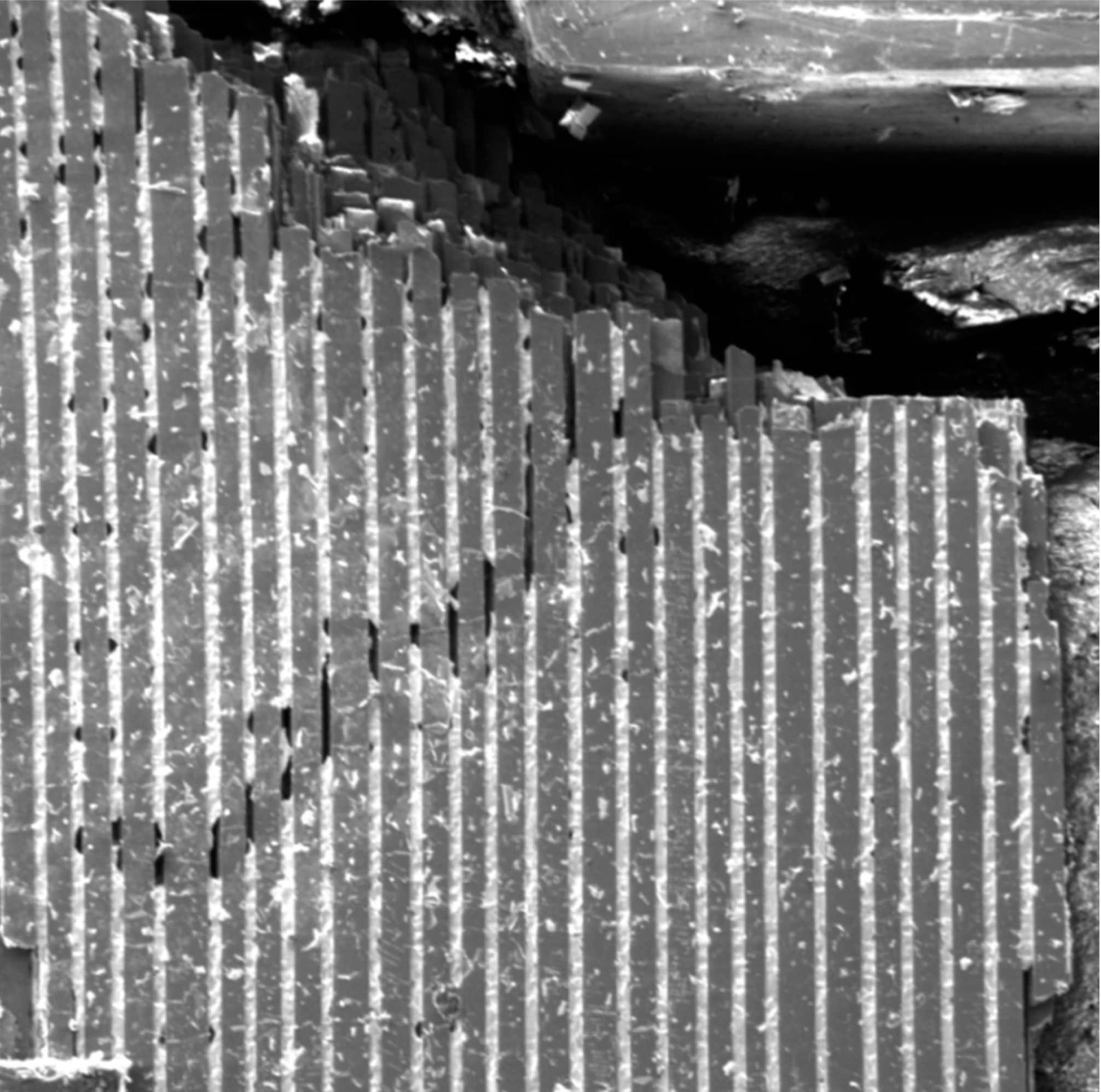
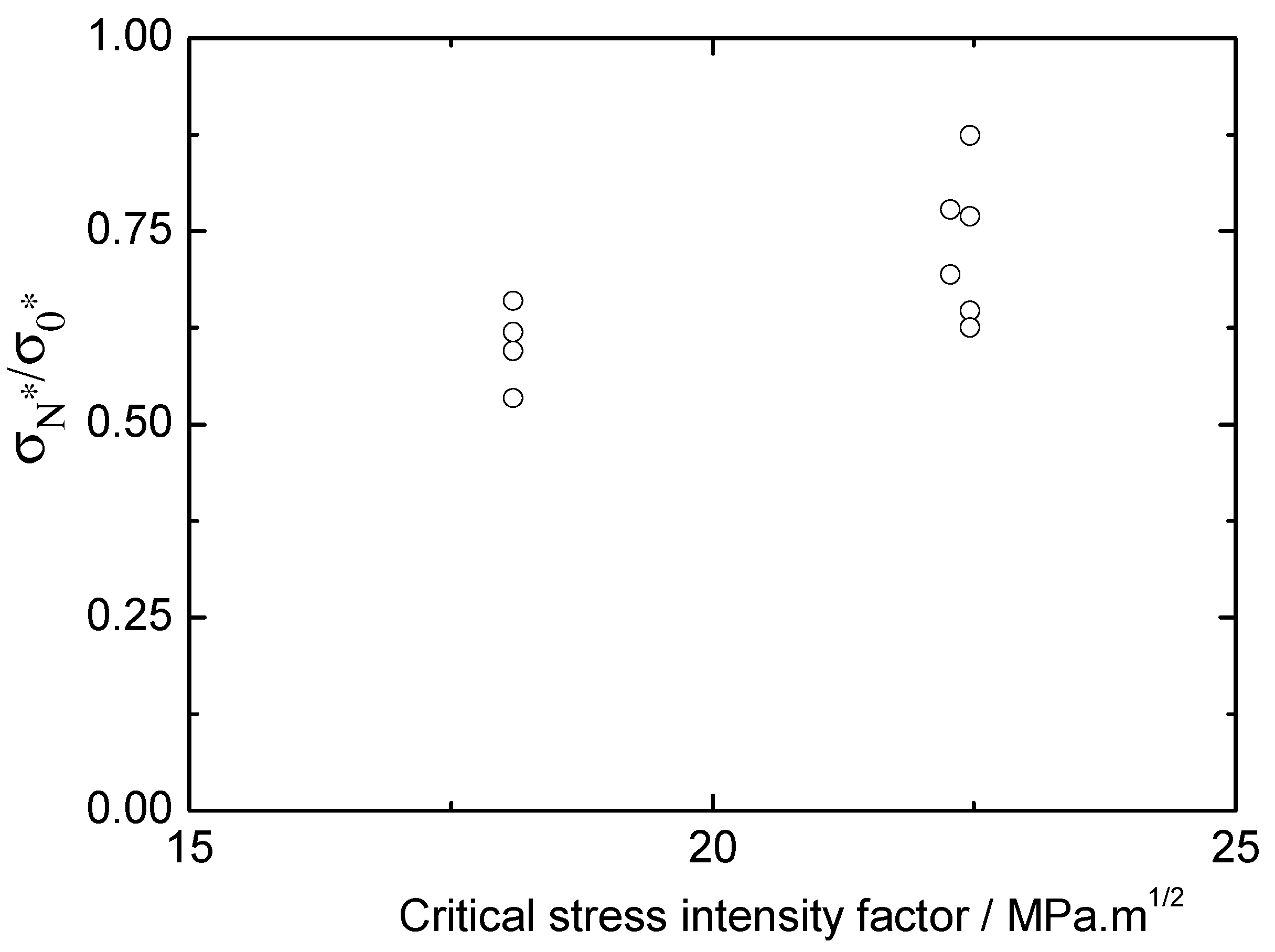
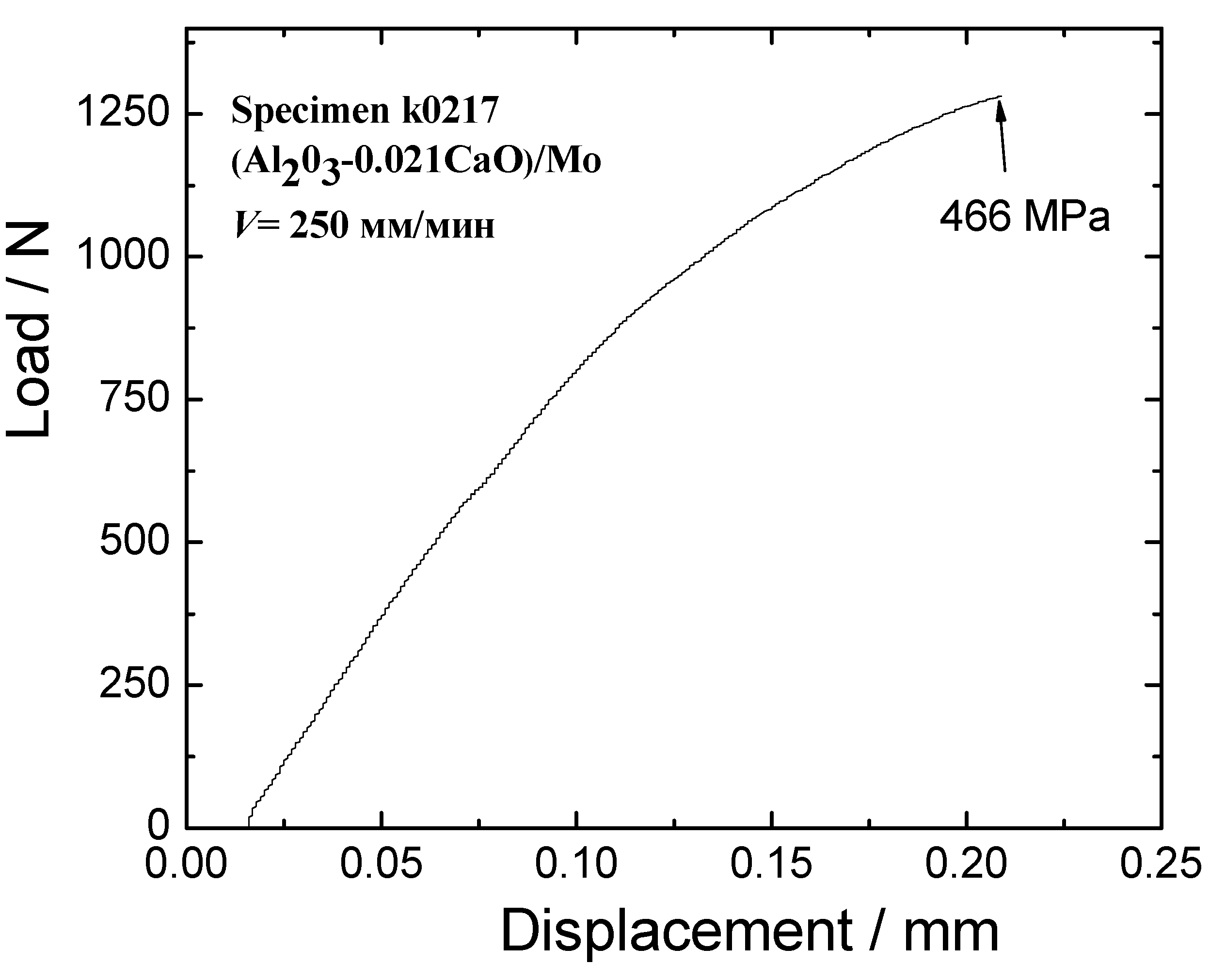
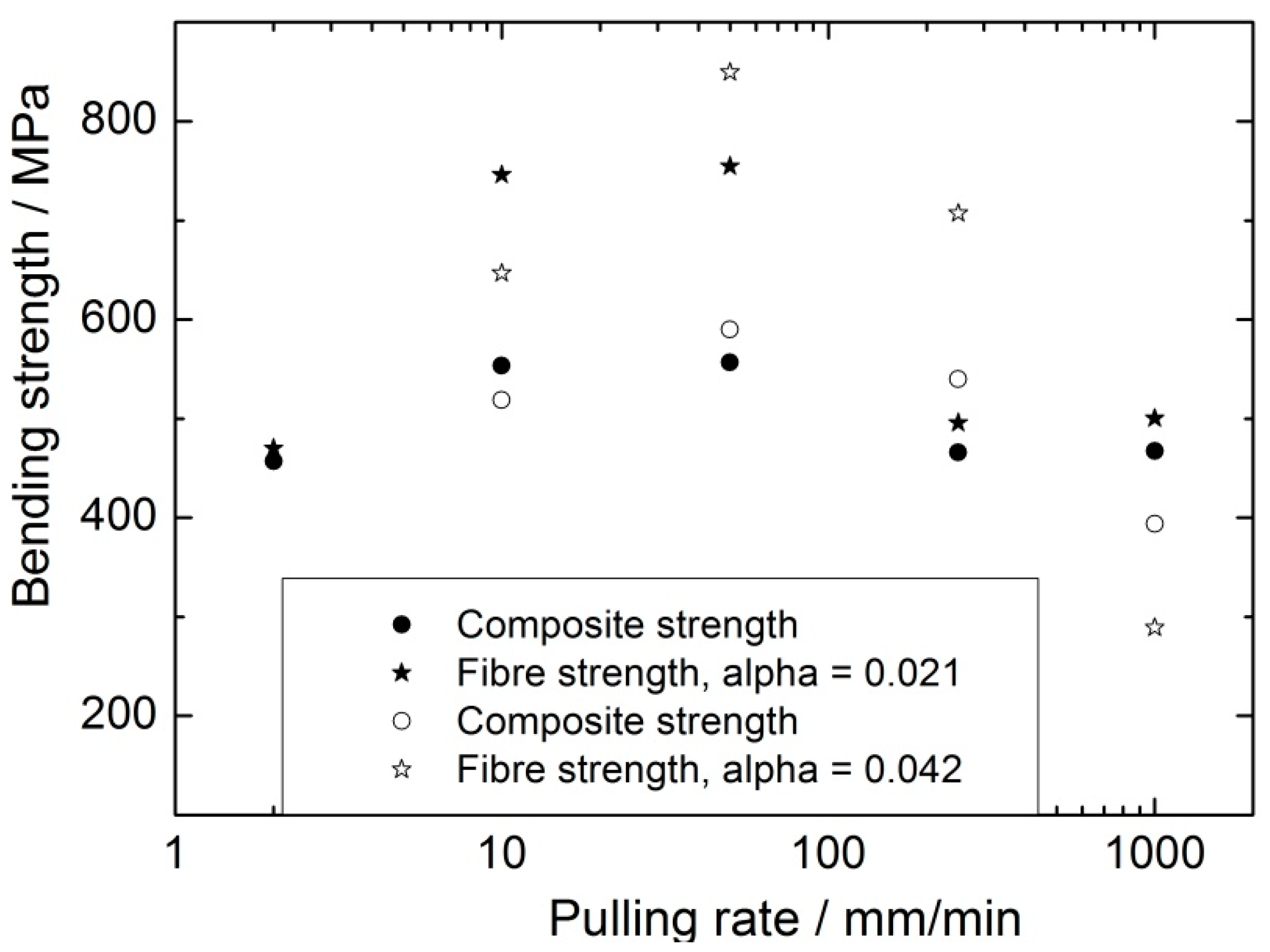
| Figure | Point | α | Crystallisation Rate/mm/min | Al:Ca | Compound | K*/MPa·m1/2 |
|---|---|---|---|---|---|---|
| Figure 2a | 1 | 0.032 | 2 | 11 | CaAl12O19 | 22.5 |
| 2 | 0.032 | 2 | 11 | CaAl12O19 | ||
| 3 | 0.032 | 2 | 9.4 | CaAl12O19 | ||
| Figure 2b | 1 | 0.032 | 2 | 4.3 | CaAl4O7 | |
| 2 | 0.032 | 2 | >100 | Al2O3 | ||
| 3 | 0.032 | 2 | 11 | CaAl12O19 | ||
| Figure 2c | 1 | 0.032 | 2 | 10 | CaAl12O19 | |
| 2 | 0.032 | 2 | 2 | CaAl2O4 | ||
| Figure 3a | 1 | 0.021 | 250 | 4 | CaAl4O7 | 22.7 |
| 2 | 0.021 | 250 | >100 | Al2O3 | ||
| Figure 3b | 1 | 0.032 | <1 | 10 | CaAl12O19 | 16.3 |
| 2 | 0.032 | <1 | 14 | CaAl12O19 | ||
| 3 | 0.032 | <1 | 4 | CaAl4O7 |
© 2017 by the authors. Licensee MDPI, Basel, Switzerland. This article is an open access article distributed under the terms and conditions of the Creative Commons Attribution (CC BY) license (http://creativecommons.org/licenses/by/4.0/).
Share and Cite
Mileiko, S.; Kolchin, A.; Kiiko, V.; Novokhatskaya, N. Composite Oxide Fibres Grown by Internal Crystallisation Method. Fibers 2017, 5, 48. https://doi.org/10.3390/fib5040048
Mileiko S, Kolchin A, Kiiko V, Novokhatskaya N. Composite Oxide Fibres Grown by Internal Crystallisation Method. Fibers. 2017; 5(4):48. https://doi.org/10.3390/fib5040048
Chicago/Turabian StyleMileiko, Sergei, Andrew Kolchin, Vyacheslav Kiiko, and Natalia Novokhatskaya. 2017. "Composite Oxide Fibres Grown by Internal Crystallisation Method" Fibers 5, no. 4: 48. https://doi.org/10.3390/fib5040048
APA StyleMileiko, S., Kolchin, A., Kiiko, V., & Novokhatskaya, N. (2017). Composite Oxide Fibres Grown by Internal Crystallisation Method. Fibers, 5(4), 48. https://doi.org/10.3390/fib5040048





